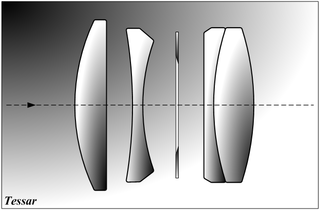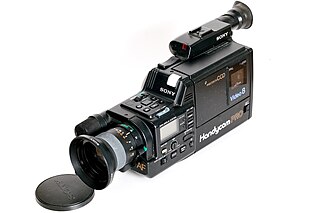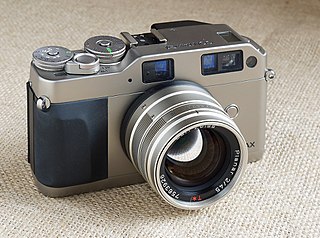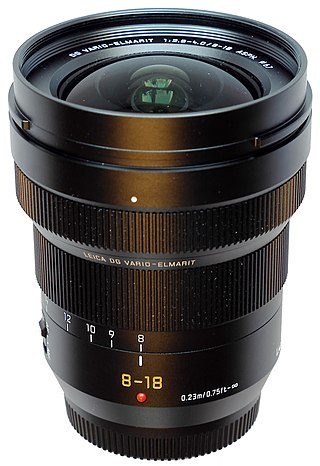
A rangefinder camera is a camera fitted with a rangefinder, typically a split-image rangefinder: a range-finding focusing mechanism allowing the photographer to measure the subject distance and take photographs that are in sharp focus. Most varieties of rangefinder show two images of the same subject, one of which moves when a calibrated wheel is turned; when the two images coincide and fuse into one, the distance can be read off the wheel. Older, non-coupled rangefinder cameras display the focusing distance and require the photographer to transfer the value to the lens focus ring; cameras without built-in rangefinders could have an external rangefinder fitted into the accessory shoe. Earlier cameras of this type had separate viewfinder and rangefinder windows; later the rangefinder was incorporated into the viewfinder. More modern designs have rangefinders coupled to the focusing mechanism so that the lens is focused correctly when the rangefinder images fuse; compare with the focusing screen in non-autofocus SLRs.

Leica Camera AG is a German company that manufactures cameras, optical lenses, photographic lenses, binoculars, and rifle scopes. The company was founded by Ernst Leitz in 1869, in Wetzlar, Germany. The name Leica is derived from the first three letters of the founder's surname (Leitz) and the first two of the word camera: lei-ca.

A camera lens is an optical lens or assembly of lenses used in conjunction with a camera body and mechanism to make images of objects either on photographic film or on other media capable of storing an image chemically or electronically.

The Tessar is a photographic lens design conceived by the German physicist Dr. Paul Rudolph in 1902 while he worked at the Zeiss optical company and patented by Zeiss in Germany; the lens type is usually known as the ZeissTessar. Since its introduction, millions of Tessar and Tessar-derived lenses have been manufactured by Zeiss and other manufacturers, and are still produced as excellent intermediate aperture lenses.

A zoom lens is a system of camera lens elements for which the focal length can be varied, as opposed to a fixed-focal-length (FFL) lens.

Voigtländer was a significant long-established company within the optics and photographic industry, headquartered in Braunschweig, Germany, and today continues as a trademark for a range of photographic products.

Contax began as a German camera model in the Zeiss Ikon line in 1932, and later became a brand name. The early cameras were among the finest in the world, typically featuring high quality Zeiss interchangeable lenses. The final products under the Contax name were a line of 35 mm, medium format, and digital cameras engineered and manufactured by Japanese multinational Kyocera, and featuring modern Zeiss optics. In 2005, Kyocera announced that it would no longer produce Contax cameras. The rights to the brand are currently part of Carl Zeiss AG, but no Contax cameras are currently in production, and the brand is considered dormant.

The Sony Cyber-shot DSC-R1 is a bridge digital camera announced by Sony in 2005. It featured a 10.3 megapixel APS-C CMOS sensor, a size typically used in DSLRs and rarely used in bridge cameras. This was the first time such a large sensor was incorporated into a bridge camera. Besides the APS-C sensor, the DSC-R1 also featured a 14.3–71.5 mm Carl Zeiss Vario-Sonnar T* lens, providing for an angle of view equivalent to 24–120 mm on a full frame camera.

Image stabilization (IS) is a family of techniques that reduce blurring associated with the motion of a camera or other imaging device during exposure.

Kiron Lenses were photographic lenses distributed by the Kiron Corporation, formerly based in Carson, California, United States.

The Nikkorex nameplate was used for a series of 35 mm film, single-lens reflex cameras sold by Japanese optical manufacturer Nippon Kogaku K.K., as well as a series movie cameras and movie projectors. The models, made by other companies, were designed and marketed as low-cost, feature-reduced equipment for the consumer market.

Sony Corporation produces professional, consumer, and prosumer camcorders such as studio and broadcast, digital cinema cameras, camcorders, pan-tilt-zoom and remote cameras.
A dialyte lens is a compound lens design that corrects optical aberrations where the lens elements are widely air-spaced. The design is used to save on the amount of glass used for specific elements or where elements can not be cemented because they have dissimilar curvatures. The word dialyte means "parted", "loose" or "separated".

The Contax G camera line consists of two cameras, the G1 and G2, interchangeable-lens cameras sold by Kyocera under the Contax brand in competition with the Leica M7, Cosina Voigtländer Bessa-R, and Konica Hexar RF. The G1 was introduced in 1994 with the G2 joining it in 1996. In 2005, Kyocera retreated from the camera business and announced it would cease all activity related to the manufacture of Contax cameras at the end of the year, effectively spelling the end of the G system.
The design of photographic lenses for use in still or cine cameras is intended to produce a lens that yields the most acceptable rendition of the subject being photographed within a range of constraints that include cost, weight and materials. For many other optical devices such as telescopes, microscopes and theodolites where the visual image is observed but often not recorded the design can often be significantly simpler than is the case in a camera where every image is captured on film or image sensor and can be subject to detailed scrutiny at a later stage. Photographic lenses also include those used in enlargers and projectors.

The Panasonic Lumix DMC-GH1 is a digital mirrorless interchangeable lens camera adhering to the Olympus and Panasonic developed Micro Four Thirds System (MFT) system design standard. Panasonic classified the GH1 as a hybrid stills/video camera and the GH1 was introduced and marketed as a higher end camera than Panasonic's first MFT camera, the stills only, non-video capable Lumix DMC-G1.

The Panasonic Lumix DMC-GH2 is a digital camera with HD video recording capability that is part of the Micro Four Thirds system. Though commonly referred to as a DSLR camera, it has no mirror or optical viewfinder, but has instead both a fold-out LCD screen and a electronic viewfinder.

The invention of the camera in the early 19th century led to an array of lens designs intended for photography. The problems of photographic lens design, creating a lens for a task that would cover a large, flat image plane, were well known even before the invention of photography due to the development of lenses to work with the focal plane of the camera obscura.
Heinz Kilfitt was born on 29 May 1898 in Hörntrop-Wattenscheid, Germany; he died on 11 August 1980 in Munich, Germany. He is probably best known for the design of the spring driven 35mm Robot still cameras taking 24×24mm frames on 135 film as well as being a lens maker, renowned for the Macro-Kilars and the manufacture of the Voigtländer Zoomar that was designed by Frank Gerhardt Back (1902-1981).

The Panasonic Leica DG Vario-Elmarit 8–18 mmf/2.8-f/4.0 lens is a digital compact ultra wide angle lens for Micro Four Thirds system cameras. It is a varifocal lens branded with the German label Leica, but manufactured by Panasonic in Japan.



















